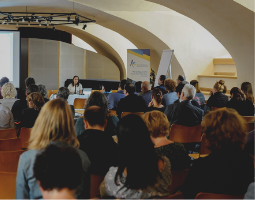The Merriam-Webster English Dictionary defines advocacy as ‘The act or process of supporting a cause or proposal’. This sounds like a very general definition in which nothing is said about the goals of advocacy, nor about the target groups that shall be addressed by advocacy activities. But even if we stay at this general level, it might be helpful to add that advocacy is always aiming at creating change.
Generally speaking, change is achieved by influencing people in positions of power. However, it would be wrong to think that people in power you might need to address, can only be found in the realm of political decision-makers. Advocacy is always about handling power. That’s why it also has to be asked who sets the tone in the public debates, but also in the internal debates of certain stakeholder groups, and how this debate can possibly be influenced in such a way that the interests of one’s own sector are given due weight.
One of the goals to which the AEC has committed as part of its ARTEMIS project is to encourage ‘players in the sector at all levels to develop, implement and apply systematic advocacy strategies and thus make the voice of the sector heard better‘ as it is stated in the project application. In order to achieve this goal, a framework strategy is currently being developed from which concrete measures can then be derived, such as an AEC Advocacy Toolkit and ideas for workshops.
The AEC Advocacy Strategy will be two-track. On the one hand, it should provide answers to the question of what the AEC can do for the benefit of its members at the European level. On the other hand, it should also make clear how the AEC can support its members in doing advocacy at the local, regional and national levels.
As a first step, a survey was launched in the autumn of 2022 to ask the AEC members about their needs and concerns related to advocacy. As a second step and on the basis of the outcomes of this survey, a strategy paper will now be developed that will, among other things, systematically list:
- the target groups of AEC’s advocacy actions;
- tools to reach out to these target groups;
- partners with whom it makes sense to join forces;
- key messages on advocacy that AEC wants to bring forward.
The strategy paper will include some basic explanations on the subject of advocacy. This will ensure, so to speak, that we are pursuing the same goals and mean the same thing when we speak of advocacy. In today’s and the following newsletters, selected chapters from this strategy paper will therefore be presented to the AEC membership thus giving an insight into the AEC strategy. Today, let’s have a closer look at what can be understood by ‘Positive Advocacy’.
What is Positive Advocacy? It could be seen as a synonym for preventive advocacy describing preventive action in the sense of not only reacting once there are real threats in the air, such as the announcement of financial cuts for cultural institutions or actions putting the autonomy of an institution or freedom of teaching at risk.
How to do positive advocacy?
One way to strengthen one’s visibility is to have clear answers to the four questions articulated below.
1) Why is higher music education relevant? Why is the AEC relevant?
2) Is your organisation’s position clear and are your goals stated clearly?
3) How up-to-date are your goals?
4) How can you make sure your voice is heard?
We invite all our members to reflect on these questions and on their advocacy needs.
The AEC Advocacy Strategy will contain our answers regarding our mission and vision as well as our advice and more day-to-day advocacy tools.






